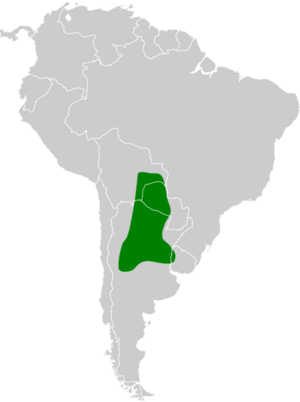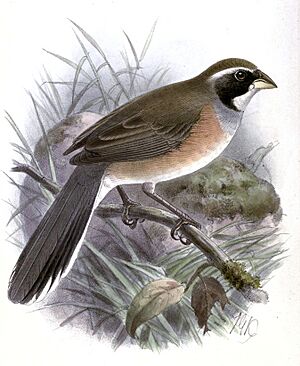Many-colored Chaco finch facts for kids
Quick facts for kids Many-colored Chaco finch |
|
|---|---|
 |
|
| Many-colored Chaco finch at Capivara, Santa Fe Province, Argentina | |
| Conservation status | |
| Scientific classification | |
| Genus: |
Saltatricula
|
| Species: |
multicolor
|
 |
|
The Many-colored Chaco finch (Saltatricula multicolor) is a small songbird that lives in parts of South America. You can find it in dry woodlands and nearby areas in Argentina, Bolivia, Uruguay, and Paraguay. Even though it's called a finch, scientists think it might be more closely related to a type of bird called a tanager.
Contents
What Does the Many-colored Chaco Finch Look Like?
The Many-colored Chaco finch is a pretty bird, about 18 centimeters (7 inches) long and weighing around 25 grams (less than an ounce). It has a bright yellow beak and a special pattern on its head.
Its body is mostly light-colored, which makes it easy to spot. Male birds have a dark gray upper beak and a mustard yellow lower beak. Their eyes are a brownish color, and their legs and feet are gray. Young birds have dull black beaks with only a hint of yellow.
How to Tell it Apart from Other Birds
Sometimes, people confuse the Many-colored Chaco finch with the Golden-billed saltator. Both birds live in the same areas and have yellow beaks. However, the Golden-billed saltator is much bigger and its colors are not as bright. It also doesn't have any white feathers on its tail, which the Many-colored Chaco finch does.
Where Does the Many-colored Chaco Finch Live?
This bird is very common in a region called the Gran Chaco. This area is a large, dry plain in South America, covered with forests and grasslands. The Many-colored Chaco finch loves to gather with other seed-eating birds in winter. They often form mixed groups that search for food on the ground.
Behavior and Habits
You'll often see these finches in pairs or small groups of five or six birds. They like to stay on the ground, especially among low bushes, in areas where fires have cleared the land, or at the edges of fields and thickets.
Because of their light colors, they stand out easily. If something scares them, they quickly fly into the bushes to find safety. Their call is a short, repeated chipping sound, a bit like a junco bird.



